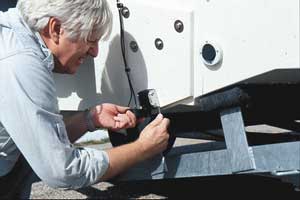
There are alternatives for days when the tuna just don’t show up at Louisiana’s hottest offshore spot.
It is no coincidence that transducers designed to be mounted on a boat’s transom are the type most often packed in the box with new sonar units. They are the easiest type for the average person to install, and they work well on just about any transom design with a place to mount them. Like any transducer, they must remain in contact with a laminar flow of water to work at speed. Mount them in a spot where turbulence or air bubble streams are directed across their working surfaces or where they lift out of the water on sharp turns, and they can’t perform any better than any other transducer would under similar conditions.
The ideal mounting location on a boat powered by an outboard or an I/O engine is about 18-24 inches starboard of the engine’s lower unit. If the boat has inboard power, mount the transducer far enough to starboard to clear any propeller turbulence.
Look for a flat area of the hull between lifting strakes on a fiberglass boat and between the longitudinal ribs on a metal hull. Don’t mount it behind through-hull fittings, patches of rivets or other hull features that could generate turbulence.
The transducer may have to be mounted closer to the centerline of a high performance hull that rides on a narrow pad when fully planed. If the transducer is mounted beside the pad, it will raise up out of the water as the boat climbs onto the pad, and the sonar unit will lose its bottom reading the instant the transducer’s face loses contact with the water.
A transducer mounted directly in front of the prop on a high-performance boat can cause prop cavitation. Sometimes pad hulls don’t have a trouble-free mounting spot on the transom, and you are better off epoxying down a transducer inside the sump area where it shoots through the pad.
Practically any transom-mounted transducer with a halfway decent installation will deliver great performance while the boat is at rest or moving at trolling speed. But the quality of the installation becomes more critical as boat speed increases. Both the front-to-rear and side-to-side transducer mounting angles are critical to high-speed performance.
The transducer should be mounted nose-up about three degrees in relation to the plane of the hull bottom. Sometimes a transducer mounted parallel with the hull bottom also works fine, but even the slightest nose-down angle can cause turbulence or cavitation that kills performance.
Most transducer brackets are not completely rigid, and water pressure against the transducer at high boat speeds can tilt it back enough to reach a nose-down angle.
The side-to-side angle should be as close as possible to parallel with a straight edge laid across both gunwales at the transom. The boat’s floor is another good parallel, but it’s not visible while you are on your hands and knees behind the boat adjusting the transducer’s bracket.
The last critical setting is the transducer’s running depth. The ideal depth will keep the transducer in contact with the water as the boat maneuvers while adding minimal drag. Metal hulls are not generally as smooth as fiberglass hulls, and usually require a deeper running depth to reach below any turbulence caused by hull irregularities.
Keep in mind that you may have to adjust a transducer’s running depth and mounting angles to get top performance at high boat speeds. Most transducer mounting brackets have mounting bolt slots instead of holes so you can loosen the screws and slide the transducer up or down and cant it slightly to make these adjustments.
I loosely assemble a transducer to its bracket and hold it against the transom to mark where I’ll drill the mounting screw holes. I mark the holes where they will give me room to slide the bracket up slightly and down considerably more on a fiberglass boat. I mark the holes closer to the bottom of the bracket slots on aluminum boats because it’s much more likely that I’ll need to move the transducer to run deeper rather than shallower to improve high-speed performance.
A properly installed transom-mounted transducer performs just as well as a shoot-through model, and you can take advantage of the temperature sensor built into most of them and the speed wheel optional on many with no additional rigging.
The transducer will also deliver greater sensitivity because it suffers none of the signal loss associated with shooting sound through a hull.


